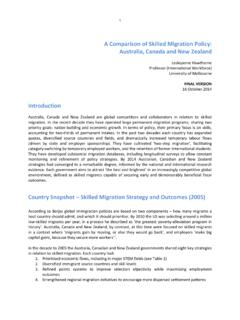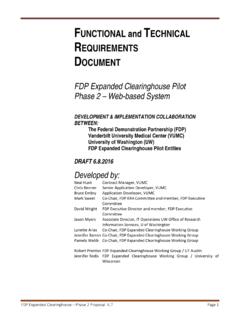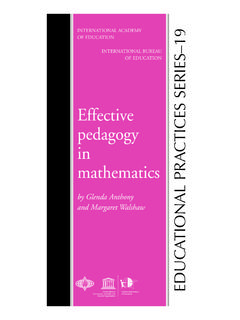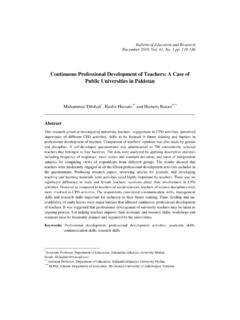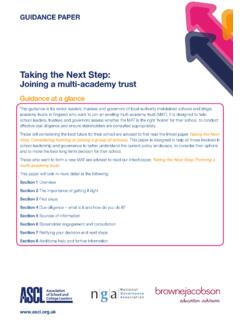Transcription of The role and purpose of practical work in the teaching and ...
1 DEPARTMENT OF educational STUDIES The role of practical work in the teaching and learning of science Robin Millar University of York Paper prepared for the Committee: High School Science Laboratories: Role and Vision, National academy of Sciences, Washington, DC October 2004 1 1 Introduction The purpose of this paper is to explore and discuss the role of practical work in the teaching and learning of science at school level. It may be useful, however, to begin with some general remarks about science and science education, to lay out a framework for the discussion later in the paper. First, and most fundamentally, we might ask: what is science, and what are its characteristics? The word science is variously used in ordinary discourse in English to refer to a product (a body of knowledge), to a process (a way of conducting enquiry) and to an enterprise (the institutionalised pursuit of knowledge of the material world1).
2 The distinctive characteristic of scientific knowledge is that it provides material explanations for the behaviour of the material world, that is, explanations in terms of the entities that make up that world and their properties. Through its choice of questions to address and the kinds of answers to accept, its methods of enquiry, and its procedures for testing and scrutinising knowledge claims, the scientific community has succeeded in building up a body of knowledge which is consensually accepted by that community and often also beyond it. Whilst this is always open to revision, its core elements are stable and beyond reasonable doubt. We value science (as a product, as an enquiry process, and as a social institution) because of its success in explaining phenomena in elegant and parsimonious ways, which are intellectually satisfying and which often facilitate the purposeful manipulation of objects, materials and events.
3 The aims of science education might then be summarised as: to help students to gain an understanding of as much of the established body of scientific knowledge as is appropriate to their needs, interests and capacities; to develop students understanding of the methods by which this knowledge has been gained, and our grounds for confidence in it (knowledge about science). The second of these is often referred to as understanding the nature of science , and encompasses elements of science both as an enquiry process and as a social enterprise. It includes an understanding of how scientific enquiry is conducted, of the different kinds of knowledge claims that scientists make, of the forms of reasoning that scientists use to link data and explanation, and of the role of the scientific community in checking and scrutinising knowledge claims. The two aims are closely inter-related. Indeed the second could be said to be entailed by the first: to claim to know something, it is not enough simply to believe it to be the case, but also necessary to have adequate evidence to support the claim (or at least to know what Norris (1992) terms the general shape that a justification would have to take (p.))
4 216)). In other words, you have to be able to say not only that you think it is the case, but also why. Additional reasons have been put forward by science educators for emphasising knowledge about science. First, a better understanding of the structure of scientific knowledge and the forms of argumentation used by scientists may help students to learn science content. Second, citizens in a modern society need some understanding of the nature of scientific knowledge in order to evaluate claims that may affect their everyday decisions ( about health, diet, energy resource use) and to reach 1 World here should be interpreted broadly; the subject matter of science is the material universe. Material includes living matter. 2 informed views on matters of public policy ( genetic therapies, methods of electricity generation). Third, the characteristics of science as a way of knowing , and its institutional norms of universalism, communalism, disinterestedness and organised scepticism (Merton, 1942), are of cultural (and perhaps moral) significance and value.
5 These rationales reflect elements of two distinct perspectives which Irwin (1995) has termed the enlightenment perspective and the critical perspective and which, he suggests, underpin the concerns of various individuals and groups to improve scientific literacy and public understanding of science. Whilst the two aims of science education identified above are closely inter-related, there is also one quite significant difference between them. The first might be stated as bringing students understandings closer to those of the scientific community. But it is rather harder to say whose ideas about science we wish to bring students understandings closer to. Unlike scientific knowledge, where there is consensus about core knowledge claims, there is rather less agreement about the characteristic features of scientific enquiry and scientific reasoning. In one sense, professional scientists clearly know more about science than any other group, but their knowledge is often largely tacit knowledge in action rather than declarative, propositional knowledge.
6 The eminent philosopher of science, Imre Lakatos, once memorably commented of scientists explicit knowledge of their practices that most scientists tend to understand little more about science than fish about hydrodynamics (Lakatos, 1970: 148). But the views of philosophers of science also differ, as do those of science educators, certainly at the level of detail and perhaps more fundamentally. Furthermore, the questions that drive enquiry, and the methods of enquiry commonly used, vary across the sciences so that generalisations about the nature of science are rarely persuasive, and are often open to rather obvious objections. In thinking about this second aim of the school science curriculum, and the role of practical work in achieving it, it may be important to be clear as to whether we wish to promote a tacit knowledge-in-action of science, or a more explicit, reflective and declarative knowledge. It is also important to distinguish, and keep in mind, that the school science curriculum in most countries has two distinct purposes.
7 First, it aims to provide every young person with sufficient understanding of science to participate confidently and effectively in the modern world a scientific literacy aim. Second, advanced societies require a steady supply of new recruits to jobs requiring more detailed scientific knowledge and expertise; school science provides the foundations for more advanced study leading to such jobs. These two purposes may lead to different criteria for selection of curriculum content, to different emphases, and (in the particular context of this paper) to different rationales for the use of practical work. In this paper, I am using the term practical work to refer to any teaching and learning activity which at some point involves the students in observing or manipulating the objects and materials they are studying. I use the term practical work in preference to laboratory work because location is not a critical feature in characterising this kind of activity.
8 The observation or manipulation of objects might take place in a school laboratory, but could also occur in an out-of-school setting, such as the student s home or in the field ( when studying aspects of biology or Earth science). I also prefer not to use the term experiment (or experimental work ) as a general label, as this is often used to mean the testing of a prior hypothesis. Whilst some practical work is of this form, other examples are not. 3 2 Science as product and process an essential tension? The close interdependence of the two main aims of science education identified above improving students scientific knowledge and their knowledge of science as a form of enquiry has led many science educators to argue that science education should combine and integrate them into a seamless whole. The idea is that students are taught to carry out their own scientific enquiries and so acquire scientific knowledge for themselves.
9 Clearly practical work has a central role in any such vision of science education. In the UK, the idea of the pupil as scientist underpinned the influential Nuffield Science Projects in the 1960s, which initiated a period of science curriculum innovation and reform that has continued to the present day. Though less prominent in subsequent developments, it has remained an influential notion in the UK and elsewhere. It is not difficult to see why it is attractive to science educators. Encouraging students to pursue their own enquiries taps into their natural curiosity. Finding things out for yourself, through your own efforts, seems natural and developmental, rather than coercive, and may also help you to remember them better. It seems to offer a way of holding up evidence, rather than authority, as the grounds for accepting knowledge. It is enabling, rather than dismissive, of the individual s ability, and right, to pursue knowledge and understanding for her/himself.
10 Indeed one of the great cultural claims of science is its potential as a liberating force that the individual can and may, though his or her own interaction with the natural world, challenge established tradition or prejudice, by confronting it with evidence. An enquiry-based approach may also encourage students to be more independent and self-reliant. In this way it supports general educational goals such as the development of individuals capacity for purposeful, autonomous action in the world. As regards knowledge about science, the enquiry-based approach often aims for a largely tacit understanding. As a result, it is difficult to assess how successful it is, as the outcomes are rather imprecise and difficult to measure. Are students becoming better enquirers or not? And how do we claim to know? As a method of teaching established scientific knowledge, however, the enquiry-based approach runs into significant difficulties in practice.






